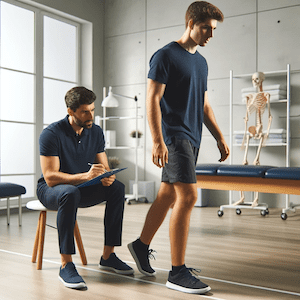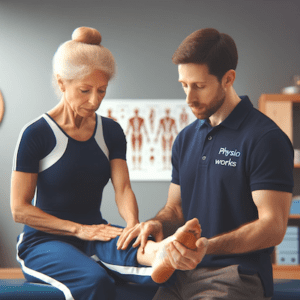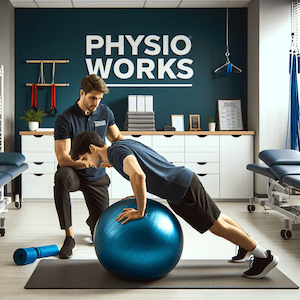Gait Analysis
Article by Shane Armfield

Gait Analysis
Improving Walking Patterns for Pain Relief and Mobility
Gait analysis, a critical aspect of physiotherapy, involves assessing an individual’s walking pattern. As a physiotherapist, I’ve seen firsthand how even minor injuries causing mild pain, stiffness, or weakness can significantly impact a person’s gait. This article aims to provide insights into the importance of gait analysis for pain relief and improved mobility.
The Importance of Gait Analysis
A poor gait not only reduces efficiency but also leads to compensatory injuries in other body parts. For example, an injured knee might cause pain in the foot, hip, or back. When you start running, maintaining a regular walking pattern becomes crucial, as abnormal stress forces are amplified, raising the risk of further injuries or arthritis.
Identifying Gait Problems
Various factors can cause deviations from a normal gait pattern. These include:
- Trendelenburg gait: Hip dipping during the stance phase, leading to hip bursitis or back pain.
- Difficulty in clearing the ground during the swing phase, which can result in hip pain.
- Insufficient weight support due to neurological disorders, increasing fall risk.
- Foot drop, increasing the risk of tripping.
- Leaning too far forward or walking with weight too far back, both increasing the likelihood of falls.
Physiotherapist’s Role in Gait Analysis
As physiotherapists, we assess your walking pattern visually and provide treatments, exercises, or tips to normalise your gait. This process can significantly improve your pain levels, movement efficiency, and overall lifestyle.
Methods of Gait Analysis
There are several methods to analyse gait:
- Observation: Physiotherapists use their expertise to detect abnormalities.
- Video Analysis: Slow-motion videos provide a detailed assessment.

Recent Advances in Gait Analysis
Recent research has introduced more sophisticated technologies in gait analysis, such as pressure mats and motion capture systems. These tools offer more detailed insights, helping physiotherapists and podiatrists develop more effective treatment plans.
The Physiotherapy Approach to Gait Correction
A tailored physiotherapy program can address specific gait issues. This may include strength training, balance exercises, or even learning to use walking aids effectively. The goal is to improve not just your gait but also your overall quality of life.
What to Do? Seeking Professional Advice
If you’re experiencing discomfort while walking or running, it’s crucial to consult a physiotherapist. Personalised guidance and targeted exercises can help you regain a normal walking pattern, alleviate pain, and enhance mobility.
Conclusion
Gait analysis plays a vital role in improving walking patterns for individuals experiencing pain or mobility issues. By identifying and addressing gait abnormalities, we can enhance movement, prevent further injuries, and significantly improve life quality. Don’t let gait problems hold you back. Take the first step towards a healthier future by seeking professional assistance.
Remember, as physiotherapists, we’re here to support your journey to pain-free movement and an improved lifestyle. Together, we can work towards a positive change in your gait and overall well-being.
Rochedale - Call 38410277
Book Online: RochedaleSalisbury - Call 32751044
Book Online: SalisburySandgate - Call 32691122
Book Online: SandgateMaximising Your Health with Physiotherapy Treatment
Exploring Physiotherapy Treatment for Pain and Injury
Physiotherapy treatment shines as a beacon of hope for individuals grappling with illnesses, injuries, or disabilities. Physiotherapists proactively utilise an array of techniques, including exercises, manual therapies, and soft tissue manipulation. Their professional skills extends to educating patients on managing pain, facilitating injury recovery, and retaining autonomy in daily functions.


Acute and Sub-Acute Injury Management
Physiotherapy treatment strategies are meticulously designed to address both acute and sub-acute injuries. With a focus on joint mobilisation, manipulation, and targeted soft tissue work, physiotherapists ensure each patient embarks on an efficient path to recovery. Supportive devices such as strapping, taping, and braces often complement these techniques.
Incorporating Alternative Therapies
In their holistic approach, many physiotherapists incorporate alternative methods like acupuncture and dry needling to augment pain relief and muscle function. Tailored physiotherapy exercises, ranging from stretching to Swiss ball workouts, are prescribed to meet the diverse needs of patients.
Specialised Physiotherapy Treatment
Specialised services within physiotherapy cater to specific groups and needs. Sports physiotherapy, women's and men's health, and workplace physiotherapy are distinct areas that address the particular challenges faced by different patient populations. Electrotherapy and local modalities such as therapeutic ultrasound and TENS machines represent the another side of physiotherapy treatments.
Targeted Physiotherapy Treatment for Injury Recovery
For those facing acute or sub-acute injuries, physiotherapists provide immediate and effective treatments that target pain, swelling, and inflammation. They blend traditional methods with innovative techniques to foster healing and functional restoration.
Hands-On Techniques in Physiotherapy
The hands-on aspect of physiotherapy is fundamental, with practitioners employing joint mobilisation, manipulation, and massage to catalyse healing and reduce discomfort. Ongoing learning and collaboration with other health professionals ensure that physiotherapy care is both comprehensive and customised.
Support Through Taping and Bracing
Physiotherapists are adept at applying various taping methods and supportive braces to aid in the stabilisation and rehabilitation process. They assess and determine the most suitable support mechanisms for each individual's condition.


Exercise Prescription for Rehabilitation
A broad spectrum of exercises is at the heart of physiotherapy treatment plans. From enhancing muscle flexibility to improving balance and proprioception, physiotherapists deliver evidence-based exercise regimens aimed at optimising recovery and function.
Biomechanical Analysis for Customised Care
A thorough biomechanical assessment underpins the physiotherapeutic approach, guiding the development of personalised treatment plans. This detailed analysis ensures that interventions are accurately targeted to address specific issues.
Specialised Physiotherapy Treatment Modalities
Hydrotherapy and sports physiotherapy offer targeted treatment options for individuals with specific needs, from aquatic exercises to specialised programs for athletes. Vestibular physiotherapy is dedicated to resolving balance disorders and associated symptoms.
Gender-Specific and Workplace Physiotherapy
Addressing the unique health concerns of both men and women, gender-specific physiotherapy utilises techniques like pelvic floor exercises. In the workplace, physiotherapy focuses on preventing and managing job-related injuries, contributing to a healthier work environment.
Conclusion: The Journey to Wellness with Physiotherapy
In conclusion, physiotherapy treatment is a richly diverse field, providing individualised care and a broad range of techniques to support patients on their path to recovery. It's essential to engage with a professional physiotherapy team to develop a tailored approach for achieving personal health and wellness objectives.
Related Articles
- Manual Physiotherapy Techniques: Focusing on joint mobilisation, manipulation, and soft tissue work, this article is ideal for readers seeking to understand the hands-on aspect of physiotherapy.
- Physio Instrument Mobilisation (PIM): This article covers the use of instrument-assisted mobilisation in physiotherapy, providing insights into how these tools aid in treatment.
- Essential Guide To Muscle Treatment: It gives an overview of muscle treatment practices in physiotherapy, including rest, ice, and heat therapies. It's helpful for readers wanting to know about muscle recovery.
- Dry Needling - An Effective Physio Treatment Explained: This article dives into the benefits and applications of dry needling in rehabilitation, discussing its effectiveness in pain management, improving joint mobility, and releasing myofascial trigger points.
- Physiotherapy & Exercise Prescription: It highlights the importance of tailored exercise regimens in physiotherapy, discussing how physiotherapists use their knowledge of exercise physiology to craft personalised treatment plans.
- Acute Injury Treatment - Soft Tissue Recovery Tips: This article offers tips and strategies for the recovery of soft tissue injuries, focusing on the role of physiotherapy in the healing process.
- Electrotherapy & Local Modalities: This piece explores physiotherapy treatment modalities like ultrasound and tens machines, and their role in treating pain disorders.



